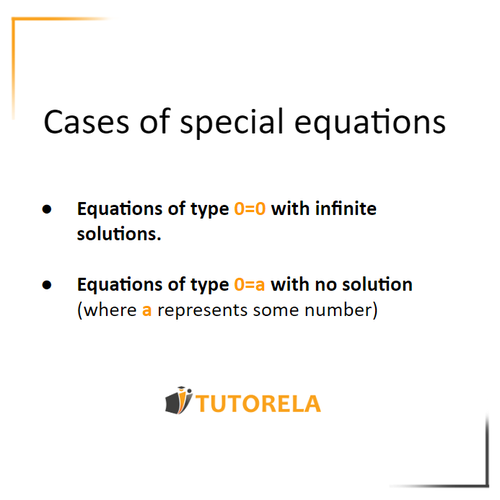So far we have seen equations with a single solution. For example, equations like this:
3x=8x−5
5x=5
x=1
This equation has a single solution, x=1
Today we will learn about a new type of equations. Equations with infinite solutions or equations with no solution at all.
Example 1: Equation with No Solution
3x+3=3x−5
3x+3=3x−5
3=−5
This is a false statement, which means that the equation has no solution. That is, there is no number that we can substitute into the equation that would make the statement true.
Join Over 30,000 Students Excelling in Math!
Endless Practice, Expert Guidance - Elevate Your Math Skills Today
Example 2: Equation with No Solution
2(2x+1)−1=4x−2
4x+2−1=4x−2
1=−2
Once again, a false statement is obtained. That is, this equation also has no solution.
Example 3: Equation with No Solution and Solution Set
x−2x−1=x−21
Firstly, as in all cases where we have a variable in the denominator, we will determine what the solution set is.
We must verify that the denominator does not equal 0. In this case, it is clear that the solution set is
x=2
Now we will continue with the exercise. We will multiply both sides of the equation by the denominator and obtain:
x−2x−1=(x−2)1
x−1=1
x=2
That is, we obtained the result x=2 However, let's remember our solution set which is
x=2
This means that the result we obtained is not within the solution set. Consequently, this exercise also has no solution. This exercise highlights why it is so important to always check the solution set.
Example 4: Equation with Infinite Solutions
Now we will look at an equation that has infinite solutions. For example, let's observe the equation
23x+3+x=2.5+3
Let's eliminate the denominator and subtract 3 from both sides:
23x+3+x=2.5x+3
3x+2x=5x
0=0
We will obtain the solution 0=0 which implies that there are infinite solutions for this equation. In this case, any x that we choose to place solves the equation. Let's demonstrate it. Let's place, for example x=1
23x+3+x=2.5x+3
let's put x=1 and we will obtain
23×1+3+1=2.5×1+3
23+3+1=2.5+3
23+4=5.5
5.5=5.5
this is indeed a true statement. Similarly, any other x that we place will yield a true statement. Now try it yourself. Put x=2 for example, or any other number.
Example 5: Equation with Infinite Solutions and Solution Set
3x−23(3x−2)=3
This is an equation with a variable in the denominator. Therefore, we must first note what the solution set is. Remember that the denominator cannot be 0. Let's look at the solution set:
3x−2=0
x=32
Let's write it clearly: The solution set is
x=32
Now let's return to the original equation
3x−23(3x−2)=3
We can multiply both sides by the denominator, but obviously it makes sense to reduce the numerator and the denominator. We will obtain:
3x−23(3x−2)=3
We will obtain
1=1
That is, we see that this equation has infinitely many solutions. Now let's remember our solution set
x=32
Therefore, for this equation, any X except 2/3 will be fine. We will note it as follows:
Solution:x=32
You can verify it by noting, for example
x=2
- any other number that is within the solution set.
Remember! Always check the solution set at the beginning of the exercise and then, upon finishing, verify the answer against it.
In conclusion, we can note
- First, we will always find out what the solution set is.
- If we get a result like 0=0, it means that our equation has infinitely many solutions.
- If we get a result like a=0 (where a is any number other than zero), that is, we obtained a false statement. In such a case, the equation has no solution.









